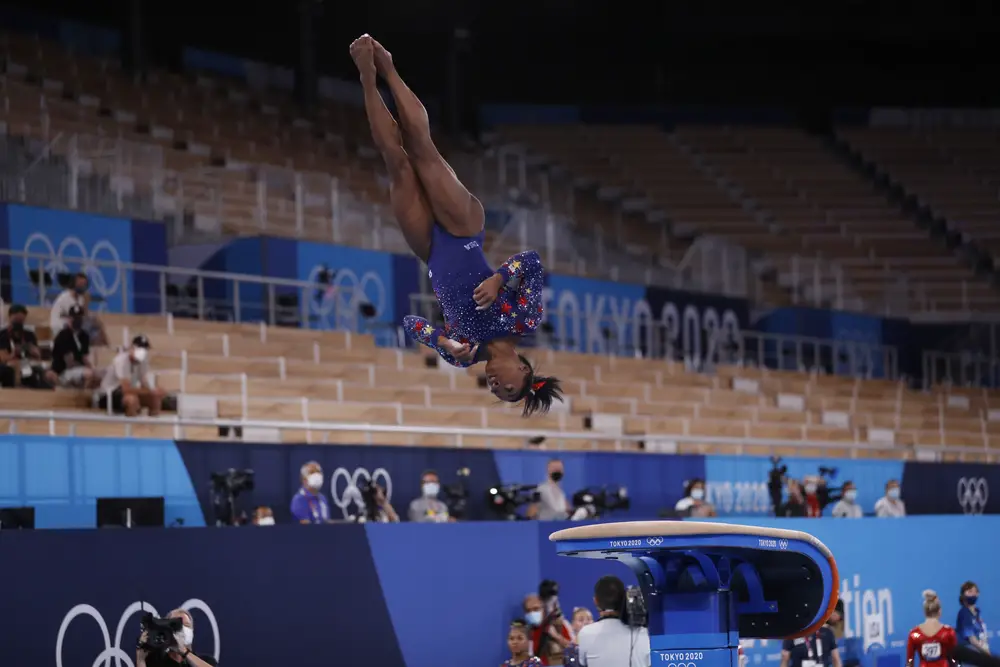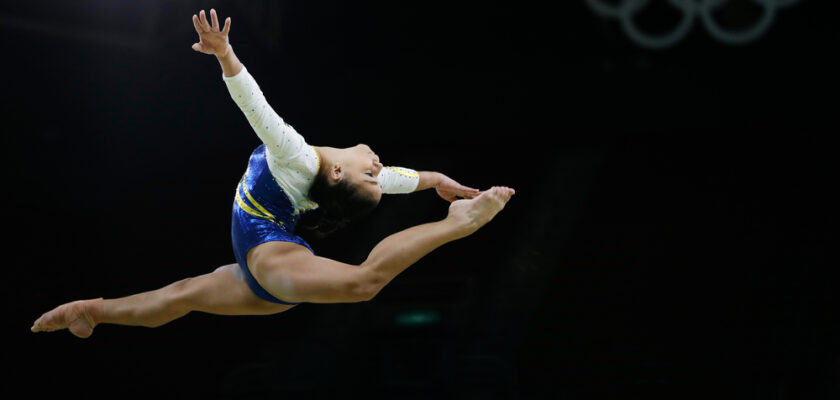Trampoline gymnastics is an Olympic discipline that combines acrobatics and jumping on a trampoline. It has evolved significantly over the years, gaining worldwide popularity and establishing itself as a top-level competition at international sporting events such as the Olympics.
Like any other sport, there are rules to trampoline gymnastics, and they need to be taken seriously. That’s why we’ve brought you this content. Get ready to learn about everything from the structure and dimensions of the competition venue to how scores are calculated.
Check out the main rules of trampoline gymnastics!
Open your Betano account and get up to R$1,000 in bonuses.
PIX payments, live games and super odds!
Click here to open your account!

Trampoline gymnastics rules: complete list
- Playing area;
- Equipment;
- Duration;
- Series;
- Scoring;
- Athletes;
- Infractions and penalties;
- Competition;
- Safety;
- Uniforms;
- Presentation.
Trampoline gymnastics rules: playing area
The trampoline, which is the centerpiece of the sport, should have the following dimensions: the jumping rectangle should measure approximately 4.28 meters long by 2.14 meters wide. In addition, the height of the trampoline in relation to the ground is approximately 1.15 meters.
Around the trampoline there must be a safety area covered with safety mats to cushion any falls. This area must be free of obstacles and at least 2 meters away in all directions from the edge of the trampoline.
Trampoline gymnastics rules: equipment
In the sport, the trampoline must be made of elastic and resistant materials, allowing for high jumps and complex acrobatics.
In addition to the main trampoline, safety mats are needed around the structure, high-strength springs and safety nets to prevent accidents.
Gymnasts also wear special socks or practice the sport barefoot to obtain better grip and control during the jumps.
The quality of the equipment is often checked before competitions to ensure that all safety standards are met.
Trampoline gymnastics rules: duration
Unlike many sports that have a specific duration for each match, trampoline gymnastics is made up of series of jumps that have an indefinite duration, depending on the performance of each athlete.
In official competitions, for example, athletes must complete a series of 10 jumps, which are assessed in sequence.
The total time of each series varies according to the execution of each athlete, but individual performance on each jump is fast, lasting just a few seconds.
Trampoline gymnastics rules: series
The jumping series in trampoline gymnastics consists of a sequence of 10 acrobatic jumps.
Each jump must be different, and the series must include a combination of single jumps, double jumps and jumps with multiple rotations and pirouettes.
The composition of the series is extremely important for the judges’ assessment, who consider both the difficulty of the jumps and the technical execution.
Athletes must plan their series strategically to maximize their score, balancing the complexity of the jumps with the need for the cleanest and most precise execution possible.
Preparation and training are essential to ensure that each jump is performed as planned.
Trampoline gymnastics rules: scoring
Scoring in trampoline gymnastics is calculated based on three main criteria: difficulty, execution and flight time. Learn more:
- Difficulty: each jump has a predetermined difficulty value, based on the complexity and maneuvers performed.
Jumps with multiple spins and pirouettes have higher difficulty values.
- Execution: the technical execution of each jump is evaluated by judges, who award marks based on the form, control, and precision of the movements.
Points are deducted for faults such as unbalanced landings or uncontrolled movements.
- Flight time: the time the gymnast stays in the air during each jump is also timed and added to the final score.
A longer flight time indicates higher jumps and better control.
Trampoline gymnastics rules: athletes
In trampoline gymnastics competitions, athletes compete individually, but there are also competitions in pairs, synchronized, and teams.
- In individual competitions, each athlete performs their series of jumps alone.
- In doubles competitions, two athletes perform their series simultaneously, with the synchrony of the movements being an additional scoring criterion.
- In team competitions, a group of athletes from the same country or club compete, and the final score is the sum of the team members’ individual scores.
Trampoline gymnastics rules: infractions and penalties
There are several infractions that can lead to penalties in trampoline gymnastics. Some of the most common infractions include:
- Landings outside the safety zone: if an athlete lands outside the designated area on the trampoline or safety mats, they lose points.
- Jump not completed: if an athlete does not complete a planned maneuver, such as a spin or pirouette, the execution is penalized.
- Fall: if the athlete falls or touches the trampoline with any part of their body other than their feet, there is a penalty.
- Lack of synchrony: in pairs competitions, if the athletes do not perform their jumps synchronously, they are penalized.
Penalties range from point deductions to disqualifications, depending on the seriousness of the infraction.
Trampoline gymnastics rules: competition
Now let’s understand how the competition works.
Before each series of jumps, the athletes have a warm-up period to prepare. They are then called to perform their series in a predetermined order.
Each jump is evaluated by a panel of judges and the score is calculated in real time. After all the rounds have been completed, the scores are added up to determine the winners. In multi-phase events, such as qualifiers and finals, the athletes with the best scores advance to the next round.
Trampoline gymnastics rules: safety
Safety is a priority in trampoline gymnastics. In addition to protective equipment around the trampoline, athletes are required to follow strict safety protocols.
These include checking the equipment before each use, constant supervision by coaches and officials, and adherence to safe jumping techniques.
Any sign of faulty equipment or other unsafe conditions, the case must be immediately reported and corrected before competition or training continues.
Trampoline gymnastics rules: uniforms
Trampoline gymnasts must wear appropriate uniforms that allow freedom of movement and are safe.
Normally, gymnasts wear tights or elastic uniforms that fit their bodies. But in official competitions, the uniform must follow the guidelines of the International Gymnastics Federation (FIG), which specifies colors, styles, and the absence of items that could compromise safety.
Trampoline gymnastics rules: presentation
The athletes’ presentation is also an important aspect of the trampoline gymnastics rules. They must demonstrate a professional and disciplined attitude from the moment they enter the competition arena until they leave.
Attitude and behavior are evaluated by the judges and can influence the overall perception of the performance, resulting in better points and more chances of winning.

Trampoline gymnastics rules: complete list
- Playing area;
- Equipment;
- Duration;
- Series;
- Scoring;
- Athletes;
- Infractions and penalties;
- Competition;
- Safety;
- Uniforms;
- Presentation.
That’s our list of the main rules of trampoline gymnastics! If you liked the content, take the opportunity to keep up to date with the world of sport by checking out our other articles!



